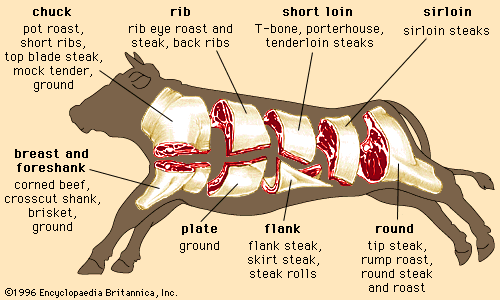The Qualities of a Particular Cut
So how does one decide which technique is best to use for any individual piece of meat? Well, that depends on three things. First, the amount of connective tissue that the cut contains. For portions like brisket and shank, there's a significant amount of connective tissue within the muscle. This connective tissue is actually what helps make these cuts so delicious. With a slow cooking approach, either roasting or braising, the connective tissue will eventually convert into a moist, delicious accent to the meat, but it is going to take some time.
The second consideration is the amount of fat the cut contains, specifically intramuscular fat. This is what creates marbling, the beautiful white fat that can be seen within the interior of a muscle. If a cut has a decent amount of marbling, there's more flexibility in the cooking method and desired internal temperature. The intramuscular fat will basically self-baste the muscle as it cooks, helping to keep the meat moist during a dry roast. However, if the cut is on the leaner side, a wet cooking method will help keep things moist with less chance of your meat drying out. Alternatively, a slow dry roast would also be appropriate for a leaner piece of meat if you monitor the internal temperature and make sure it does not overcook (for example, medium rare for sliced roast beef).
The third consideration is the amount of work the muscle does. While a tenderloin or top round steak may not have much connective tissue, these cuts are going to possess different qualities of tenderness due to the amount of workload. The tenderloin is situated in the middle of the animal, which does very little work, while the top round is from the hind leg. The tenderloin only needs a good sear for delicious, tender results. Even if it's overcooked, it's still going to be tender. The top round steak, on the other hand, will benefit from a marinade before being seared, or alternatively, a quick sear followed by a braise until fork tender
